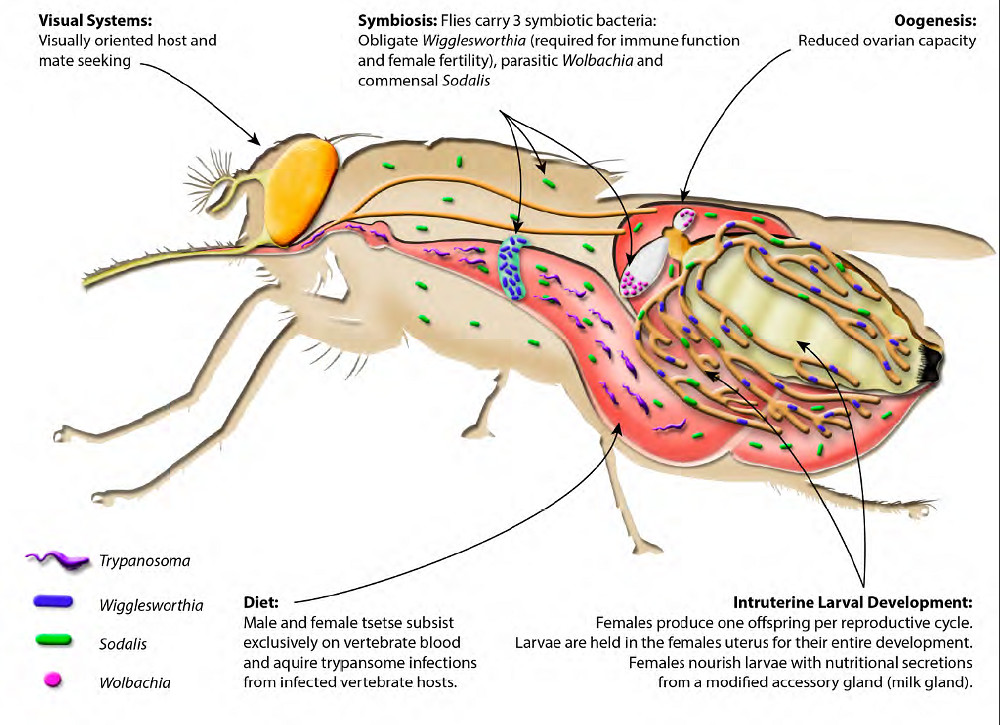Tsetse fly genome reveals weaknesses

The tsetse fly spreads the parasitic diseases human African trypanosomiasis, known as sleeping sickness, and Nagana that infect humans and animals respectively. Throughout sub-Saharan Africa, 70 million people are currently at risk of deadly infection. Human African trypanosomiasis is on the World Health Organization’s (WHO) list of neglected tropical diseases and since 2013 has become a target for eradication. Understanding the tsetse fly and interfering with its ability to transmit the disease is an essential arm of the campaign.
This disease-spreading fly has developed unique and unusual biological methods to source and infect its prey. Its advanced sensory system allows different tsetse fly species to track down potential hosts either through smell or by sight. This study lays out a list of parts responsible for the key processes and opens new doors to design prevention strategies to reduce the number of deaths and illnesses associated with human African trypanosomiasis and other diseases spread by the tsetse fly.
“Tsetse flies carry a potentially deadly disease and impose an enormous economic burden on countries that can least afford it by forcing farmers to rear less productive but more trypanosome-resistant cattle. Our study will accelerate research aimed at exploiting the unusual biology of the tsetse fly. The more we understand, the better able we are to identify weaknesses, and use them to control the tsetse fly in regions where human African trypanosomiasis is endemic.”
Dr Matthew Berriman Co-senior author from the Wellcome Trust Sanger Institute
The team, composed of 146 scientists from 78 research institutes across 18 countries, analysed the genome of the tsetse fly and its 12,000 genes. The project, which has taken 10 years to complete, will provide the tsetse research community with a free-to-access resource that will accelerate the development of improved tsetse-control strategies in this neglected area of research.
The tsetse fly is related to the fruit fly – a favoured subject of biologists for more than 100 years – but its genome is twice as large. Within the genome are genes responsible for its unusual biology. The reproductive biology of the tsetse fly is particularly unconventional: unlike most insects that lay eggs, it gives birth to live young that have developed to a large size by feeding on specialised glands in the mother.
Researchers found a set of visual and odour proteins that seem to drive the fly’s key behavioural responses such as searching for hosts or for mates. They also uncovered the photoreceptor gene rh5, the missing link that explains the tsetse fly’s attraction to blue/black colours. This behaviour has already been widely exploited for the development of traps to reduce the spread of disease.
“Though human African trypanosomiasis affects thousands of people in sub-Saharan Africa, the absence of a genome-wide map of tsetse biology was a major hindrance for identifying vulnerabilities. This community of researchers across Africa, Europe, North America and Asia has created a valuable research tool for tackling the devastating spread of sleeping sickness.”
Dr Serap Aksoy Co-senior author from the University of Yale
Tsetse flies have an armament of salivary molecules that are essential for feeding on blood. The team found one family of genes, the tsal genes, that are particularly active in the salivary glands of the tsetse fly. This allows the tsetse fly to counteract the responses from the host to stop bloodfeeding. This finding and several others are explored in more detail in eight research papers that accompany the publication of the tsetse fly genome in Science.
“This information will be very useful to help develop new tools that could reduce or even eradicate tsetse flies. African sleeping sickness is understudied, and we were very pleased to help bring together so many research groups to work collaboratively with the one shared goal in sight – the elimination of this deadly disease.”
Dr John Reeder Director of the Special Programme for Research Training in Tropical Diseases, at the World Health Organization (WHO)
More information
Publication details
Associated studies can be found on the PLOS website.
Funding
Please see the paper for a full list of funding bodies.
Participating Centres
Please see the paper for a full list of participating centres.
Publications:
Selected websites
The Wellcome Trust Sanger Institute
The Wellcome Trust Sanger Institute is one of the world’s leading genome centres. Through its ability to conduct research at scale, it is able to engage in bold and long-term exploratory projects that are designed to influence and empower medical science globally. Institute research findings, generated through its own research programmes and through its leading role in international consortia, are being used to develop new diagnostics and treatments for human disease.
The Wellcome Trust
The Wellcome Trust is a global charitable foundation dedicated to achieving extraordinary improvements in human and animal health. We support the brightest minds in biomedical research and the medical humanities. Our breadth of support includes public engagement, education and the application of research to improve health. We are independent of both political and commercial interests.


